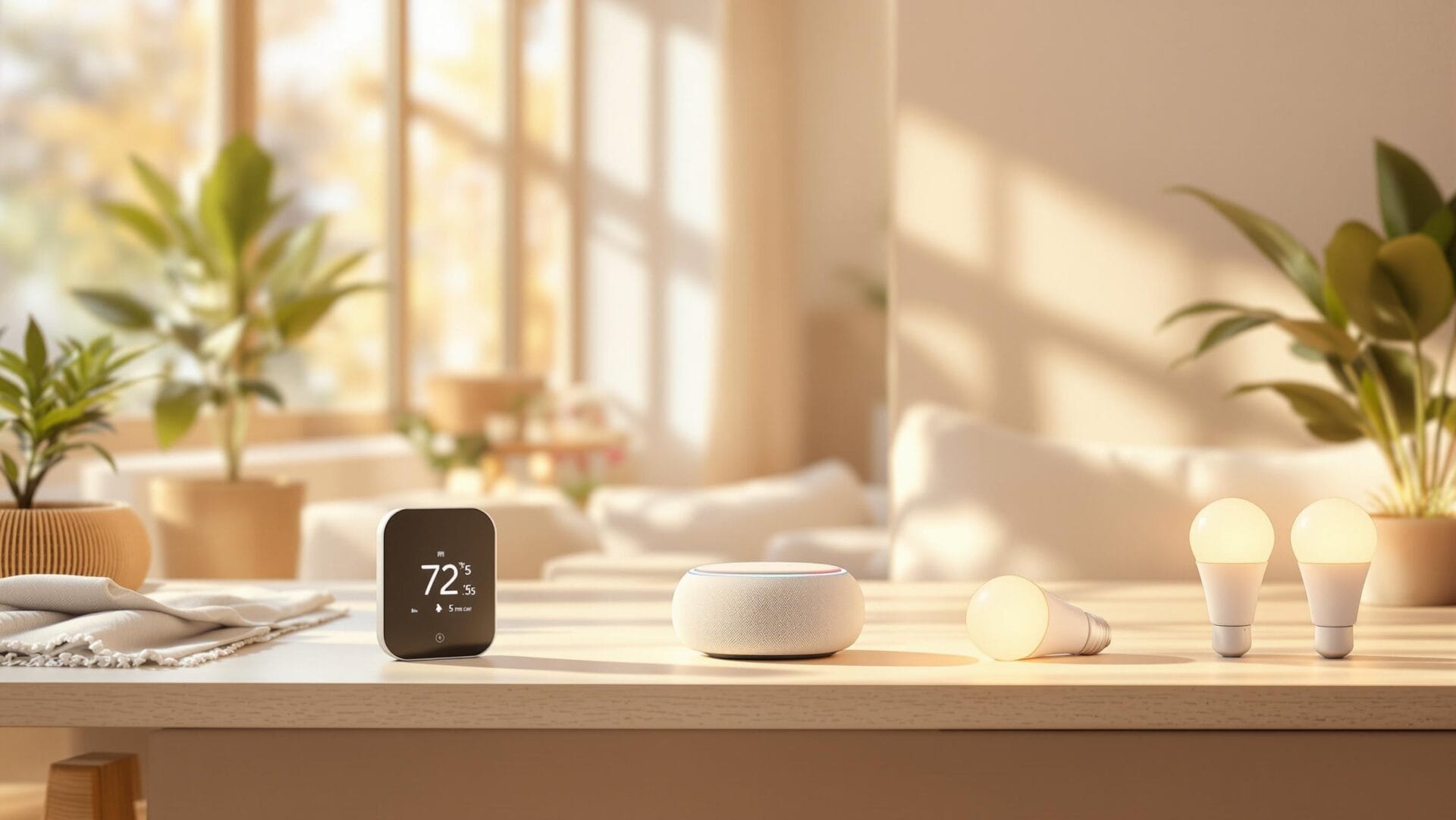Smart home devices make life easier by automating tasks like lighting, security, and temperature control. They rely on IoT protocols to communicate and work together. Here's what you need to know:
- Wi-Fi: Ideal for high-data tasks, such as streaming cameras and speakers. Offers fast speeds but uses more power.
- Zigbee & Z-Wave: Ideal for low-power devices, such as sensors. They use mesh networks for better coverage.
- Thread & Matter: Emerging standards improving compatibility and security across brands.
- Bluetooth Low Energy (BLE): Ideal for short-range, battery-powered devices such as locks and trackers.
Quick Comparison:
| Protocol | Best For | Range | Power Usage | Max Devices | Mesh Support |
|---|---|---|---|---|---|
| Wi-Fi | Cameras, speakers | ~150 ft | High | 250+ | Limited |
| Zigbee | Sensors, switches, bulbs | 30–60 ft | Very Low | 65,000 | Yes |
| Z-Wave | Security, thermostats | ~100 ft | Very Low | 232 | Yes |
| Thread | Home automation, sensors | 30–60 ft | Low | 250+ | Yes |
| BLE | Locks, trackers | ~30 ft | Very Low | 8 active | No |
Choose devices based on your needs. For example, Wi-Fi works well for data-heavy gadgets, while Zigbee and Z-Wave are better for energy-efficient sensors. Matter is simplifying compatibility, so look for Matter-certified devices for a seamless setup.
Main IoT Protocols for Smart Homes
Wi‑Fi Networks
Wi-Fi operates on 2.4 GHz or 5 GHz frequencies and, with Wi-Fi 6, supports speeds of up to 9.6 Gbps. This makes it perfect for devices like video doorbells and security cameras that stream HD video. Popular smart home devices
, such as Amazon Echo and Ring Doorbells, depend on Wi-Fifor their high speed and direct internet connection.
Key benefits of Wi‑Fi include:
- Direct internet access without needing extra hubs
- High bandwidth, ideal for streaming and data-heavy devices
- Coverage range up to 150 feet indoors
- Compatibility with smartphones and other devices
On the flip side, Wi‑Fi devices tend to consume more power and can struggle with interference on crowded networks. For more efficient home automation, other protocols, such as mesh networks, may be better suited.
Zigbee and Z‑Wave Systems
Zigbee and Z‑Wave are mesh networking protocols tailored for smart home automation. Zigbee, used by systems
such as Philips Hue and Aqara Smart Hubs, operateon a 2.4 GHz frequency and can support up to 65,000 devices. Z‑Wave, on the other hand, operates between 800-900 MHz, which helps it avoid Wi‑Fi interference and improves its ability to penetrate walls.
Why Zigbee and Z‑Wave stand out:
- Low power consumption
- Reliable and efficient mesh networking
- Minimal interference from other devices
- Long-lasting battery life for connected devices
A Z‑Wave switch can last 5–10 years on a single battery, while Zigbee sensors typically last 2–3 years. As these mesh networks evolve, newer protocols such as Thread and Matter are also gaining traction due to their enhanced features.
Thread and Matter Standards
Thread, supported by companies like Apple, Google, and Amazon, is an IPv6-based mesh protocol that creates a self-healing network. Matter, on the other hand, focuses on unifying communication across different protocols, ensuring better compatibility and security.
Key features of Thread and Matter include:
- Local device control for faster response times
- Improved security measures
- Compatibility across platforms and ecosystems
- A streamlined setup process for users
These protocols aim to simplify smart home integration while boosting performance and security.
Bluetooth Low Energy
Bluetooth Low Energy (BLE) is ideal for devices that only need to transfer small amounts of data. It's commonly found in smart locks, fitness trackers, sensors, and switches.
With a range of about 30 feet, BLE consumes very little power. Devices running on BLE can last 6 to 12 months on a single coin cell battery. Although its range and capabilities are more limited compared to Wi-Fi or mesh networks, BLE's efficiency makes it an excellent choice for battery- or solar-powered gadgets that don't require constant connectivity.
Comparing IoT Protocols
Each protocol has its strengths, catering to different smart home needs. Here's a quick comparison:
| Protocol | Range | Power Usage | Max Devices | Best For |
|---|---|---|---|---|
| Wi‑Fi | ~150 ft | High | 250+ | High-data devices |
| Zigbee | 30–60 ft | Very Low | 65,000 | Sensors, switches, bulbs |
| Z‑Wave | ~100 ft | Very Low | 232 | Security devices, thermostats |
| Thread | 30–60 ft | Low | 250+ | Home automation, sensors |
| BLE | ~30 ft | Very Low | 8 active | Battery-powered devices |
Choosing the right protocol depends on the specific requirements of your smart home setup, from device type to energy efficiency and connectivity needs.
Smart Home Protocols Explained
Protocol Feature Comparison
This section breaks down key protocol features to help you choose the best option for your smart home devices.
Here’s a quick look at how the protocols stack up:
| Feature | Wi‑Fi | Zigbee | Z‑Wave | Thread | BLE |
|---|---|---|---|---|---|
| Frequency | 2.4/5 GHz | 2.4 GHz | ±900MHz | 2.4 GHz | 2.4 GHz |
| Latency | 10-20ms | 15-30ms | 35-100ms | 20-30ms | 2.5-6ms |
| Security | WPA3 | AES-128 | AES-128 | AES-128 | AES-128 |
| Mesh Support | Limited | Yes | Yes | Yes | No |
| Battery Life | Days-weeks | 2-3 years | 5-10 years | 1-2 years | 6-12 months |
| Setup Complexity | Medium | High | High | Low | Low |
These details highlight the strengths of each protocol and how they cater to different smart home needs.
Wi‑Fi, for example, has higher latency, making it less ideal for tasks like smart locks that demand quick responses. On the other hand, BLE offers lightning-fast response times (2.5-6ms), perfect for devices like proximity sensors.
For larger homes, mesh networking is a game-changer. Z‑Wave can handle up to 4 signal hops, making it great for multi-story setups. Meanwhile, Thread adds reliability with its self-healing network, automatically rerouting signals if a device goes offline.
Battery life is another critical factor. Z‑Wave sensors can run for 5-10 years on a single battery, while Wi‑Fi cameras often need constant power or frequent recharging, limiting placement options.
Finally, ease of setup matters. Thread simplifies installation, taking just minutes, while Zigbee and Z‑Wave often require additional hubs and more configuration time.
Choosing the right protocol based on these metrics ensures your smart home runs smoothly, securely, and efficiently.
Setting Up Your Smart Home
Choosing the Right Devices
When picking devices, make sure they match your network's needs. For instance, Wi-Fi is ideal for high-bandwidth devices like surveillance cameras and video doorbells. On the other hand, battery-powered sensors perform better with low-energy options such as Z-Wave or Zigbee. For smart lighting, mesh networking can be a game-changer, ensuring reliable connectivity across your home.
Smart Home Hubs
A hub can simplify managing your smart home by connecting devices that use different protocols. Look for a hub that supports multiple protocols and can handle tasks locally. This way, your devices can still work together even when the internet is down.
Setting Up Voice Control
To get started, download the app for your voice assistant, add your devices, and follow the instructions provided in the app. If you're using a hub, link it to your voice assistant for easier control. Place your voice controllers in central spots within each room, away from barriers or anything that might cause interference.
What's Next for Smart Homes
Smart homes are advancing with updates to IoT protocols, smarter automation, and improved security measures.
Matter Protocol Updates
The Matter protocol is expected to make smart home devices work better together. Simplifying how devices communicate reduces the need for multiple hubs and makes managing your smart home easier. This means smoother compatibility across devices from different brands.
AI in Smart Homes
Artificial intelligence is making smart homes smarter by learning your habits and adjusting to your needs. Here’s how AI is shaping the future of smart homes:
- Automation that learns: AI can track your daily routines and adjust settings accordingly, like dimming lights or adjusting the thermostat.
- Personalised environments: It can create settings tailored to individual preferences, whether it’s music, lighting, or temperature.
- Smarter voice control: Improved natural language processing means voice assistants will understand you better and respond more naturally.
Security Updates
Keeping smart homes secure is a top priority. Upgrades include stronger encryption, real-time threat detection tools, and advanced authentication methods such as 2FA and biometrics. Automated security responses also help protect your devices while safeguarding your privacy.
Summary
Smart home IoT protocols are the backbone of any connected home setup. Wi‑Fi handles high-bandwidth tasks for data-heavy devices, while Zigbee and Z‑Wave are better suited for low-power, low-latency operations. The new Matter standard is shaping up to make devices work together more easily, simplifying smart home integration.
Big-name manufacturers are now embracing universal standards, improving compatibility and expanding the capabilities of smart homes. Voice assistants like Amazon Alexa and Google Assistant have also stepped up with Alexa+ and Gemini, managing multiple devices while using advanced security measures, such as end-to-end encryption and real-time threat detection.
Next Steps
Here’s how you can upgrade or build a secure and efficient smart home system:
- Check Your Network: Make sure your Wi-Fi router is secure and can support multiple devices and IPv6 capabilities for better compatibility moving forward.
- Pick Compatible Devices: Look for products that either support Matter, Zigbee, or the protocol you prefer.
- Start with Essentials: Begin with key devices such as an Ikea, Philips or Aqara hub. Then build on it with smart lights or a thermostat.
- Go Pro: Platforms like Home Assistant and Homey automate your smart home devices across multiple protocols and platforms.
Focus on building a system that works seamlessly while keeping your data safe.
Subscribe to our newsletter to get the latest updates and news








Member discussion